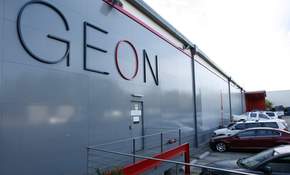
The full-year figures for Geon Group Australia Pty Ltd to 30 June 2010 were published on ASIC today. They do not include the entire contribution from its New Zealand operations – while revenue in this set of accounts was $196.7m, Geon’s actual turnover is believed to be closer to $300m.
The set of accounts includes a $62.9m goodwill write-down and a net loss of $107m. However, these aren’t as painful as last year’s $80.9m goodwill impairment and $137.5m loss.
Regarding the goodwill write-down, Geon chief financial officer Ashley Fenton told ProPrint: “The directors have taken the view, as they did last year, to take a prudent approach and recognise the realities of the business’s performance and the industry’s performance.”
The report shows that Geon had fallen into a negative equity position of $215.9m, a decline of $51m from the $164m deficiency in equity it reported in the 2009 financial year.
Receipts from customers were $220.4m – $1.6m lower than the $222m it paid out to suppliers and employees over the year.
While the results paint a bleak picture of Geon’s trading in Australia for the year to 30 June 2010, the group’s financial position has changed markedly following its debt restructure on 27 January 2011.
Fenton said: “The restructure has pushed us into a positive equity position and that is one of the very strong messages we were getting across with the announcement a couple of weeks ago. As well as reducing our debt, it puts us into a positive net equity position.”
While the impact of this restructure is not seen in the published figures, the report did includes details of the deal Geon struck with its bankers.
The key features of the new debt package include a reduction in the loan facility from $243.7m to $80m.
The debt itself is due in one lump sum on 30 June 2015, but the package also include a “cash sweep” condition, meaning that a percentage of Geon’s free cash flow above the minimum operating cash balance will go to servicing the debt.
Interest payments have also been restructured, meaning Geon is on a “pay if you can” basis for the next 12 months. After that, interest will be required on $40m of the loan.
The documents confirm that the deal was constructed as some kind of debt-for-future-equity swap.
The reports said: “As part of the refinancing, the group’s bankers have been granted certain rights under an ‘Exit Participation Deed’, which provides them with the ability to share in any profits that may arise in the event the existing shareholders exit the business.”
Auditors PricewaterhouseCoopers wrote in the report that “there is material uncertainty as to whether the consolidated entity will continue as a going concern unless it is able to meet its revenue and cash flow projections and have continued access to its borrowing facilities”.
Fenton said this kind of stern warning from auditors was not out of the ordinary. “We had stronger language last year. It is not uncommon. In the last two years, a lot of companies have similar language [from auditors]. It is slightly softer this year than it was last year and we would anticipate that if we deliver some runs on the board, it will be softer again next year.”
Geon moved its headquarters from NZ to Australia in May 2010 and was not required to provide these full-year accounts. Fenton stressed that if the report had included consolidated results from NZ, it would lend a more positive spin to the figures.
Comment below to have your say on this story.
If you have a news story or tip-off, get in touch at editorial@sprinter.com.au.
Sign up to the Sprinter newsletter

Well done suppliers!!!
Supporting Phoenix companies that dump debt and burn suppliers only hurts the industry.
$300 million of work back into the industry is around 4% more work for the people that pay their bills.
Hopefully suppliers not supporting rebirths will reduce unsustainable pricing, in an 8.3 billion dollar industry just a 1% increase in prices, will add $83 million of profit.
The industry will be healthier for it and maybe employees that have been affected can be employed in what may even become a more sustainable industry